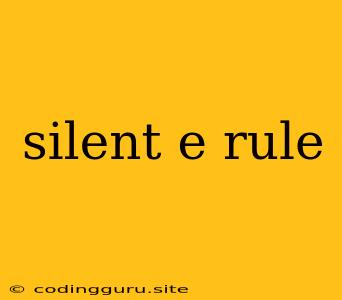Understanding the Silent 'E' Rule: A Guide to English Pronunciation
The English language is known for its quirks, and one of the most prominent is the silent 'e' rule. This seemingly simple rule can be a source of confusion for both native and non-native speakers. So, what exactly is the silent 'e' rule, and how can we understand its impact on pronunciation?
What is the Silent 'E' Rule?
The silent 'e' rule refers to the phenomenon where a final 'e' at the end of a word often remains silent, while also affecting the sound of the preceding vowel. This rule applies to many English words, making it an essential part of correct pronunciation.
Example:
- "Cake" - The 'e' at the end is silent, and the vowel 'a' has a long sound, making it "kayk".
- "Hope" - The 'e' at the end is silent, and the vowel 'o' has a long sound, making it "hohp".
Why is the 'e' Silent?
The silent 'e' rule stems from the historical development of the English language. In Old English, the 'e' at the end of a word was pronounced, but over time, it became silent. This silent 'e' acts as a signal, indicating that the preceding vowel should have its long sound.
Exceptions to the Rule
Like many rules in English, the silent 'e' rule has exceptions. There are words ending in 'e' where the 'e' is pronounced, such as:
- "Me"
- "Be"
- "She"
- "He"
Additionally, some words ending in 'e' have a short vowel sound, even though the 'e' is silent. These include:
- "Have"
- "Give"
- "Live"
Tips for Mastering the Silent 'E' Rule
- Pay attention to the vowel sound: The silent 'e' usually indicates a long vowel sound. Practice saying words with the 'e' at the end and listen for the long vowel sound.
- Memorize common words: Many common words ending in 'e' follow the silent 'e' rule. Make a list of these words and practice saying them aloud.
- Look for patterns: As you read and write, notice patterns in words that follow the silent 'e' rule. This will help you identify these words more easily.
- Use resources: There are many resources available online and in libraries that can help you understand and practice the silent 'e' rule.
The Silent 'E' and Word Formation
The silent 'e' plays a significant role in word formation. Adding an 'e' to the end of a word can change the pronunciation of the preceding vowel, and create new words with different meanings.
Example:
- "Hop" - Short vowel sound
- "Hope" - Long vowel sound
The Silent 'E' and Spelling
The silent 'e' rule also plays a crucial role in spelling. Many words have different spellings depending on whether they have a long or short vowel sound.
Example:
- "Cat" - Short vowel sound
- "Cate" - Long vowel sound (This word does not exist in English)
Conclusion
The silent 'e' rule, while seemingly straightforward, can be challenging to fully grasp. However, by understanding its historical context and practicing its application, you can significantly improve your pronunciation and spelling in the English language.
Remember, learning the silent 'e' rule is an ongoing process, and by paying attention to patterns, practicing, and using available resources, you can navigate this rule with confidence.
